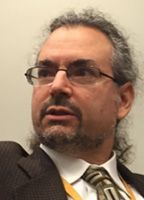
- Professor of Biochemistry and Biophysics
Phone:
(212) 746-6634
Email:
Lab Website:
Bio:
The Boudker Lab studies membrane transporters with particular interest in how the structural dynamics of these proteins underlies function.

- Associate Professor of Biochemistry and Biophysics
Phone:
(646) 962-2784
Email:
Research Area :
Lab Website:
Bio:
The Dittman laboratory is interested in synaptic function at the molecular and circuit levels. The lab is currently focused on three lines of research: spatial and temporal dynamics of synaptic proteins, the mechanisms underlying synaptic vesicle fusion and its modulation, and the impact of axonal ER on synapse function, axon integrity, and neurodegeneration.

- Professor of Biochemistry and Biophysics
Phone:
(212) 746-6557
Email:
Lab Website:
Bio:
The Eliezer laboratory is primarily involved with the application of NMR spectroscopy to problems in non-native structural biology. This includes characterizing the location and extent of structure in and the intermolecular interactions of aggregation-competent partially unfolded states of proteins involved in neurodegenerative disease. Specific targets include Alzheimer's Disease and Parkinson's Disease related proteins.

- Professor of Biochemistry and Biophysics
Phone:
(212) 746-6362
Email:
Research Area :
Bio:
The Huang Laboratory deciphers the structural biochemistry of membrane-spanning signaling proteins—particularly seven-transmembrane GPCRs and single-pass receptors—to reveal the molecular logic of cross-membrane communication. Additionally, we engineer small-molecule fascin inhibitors that arrest tumor metastasis and invigorate intratumoral dendritic cells, opening new frontiers in precision cancer therapy.

- Professor of Biochemistry and Biophysics
Email:
Research Area :
Lab Website:
Bio:
The Leschziner lab investigates the biological functions of macromolecular dynamics using cryo-electron microscopy combined with biophysical, biochemical, and cell biological methods. Their research centers on three main areas: Parkinson’s Disease mechanisms, microtubule-based intracellular transport, and chromatin structure and regulation.

- Associate Professor of Biochemistry and Biophysics
Phone:
(646) 962-3005
Email:
Research Area :
Lab Website:
Bio:
The Levitz laboratory uses a variety of optical techniques to improve our understanding of synaptic signaling molecules with a focus on neurotransmitter-gated G protein-coupled receptors (GPCRs). The lab is particularly interested in probing GPCRs at the molecular, synaptic, and circuit levels to gain a more coherent and mechanistic view of their roles in physiology and neuropsychiatric disease.

- Assistant Professor of Biochemistry and Biophysics
Phone:
(646) 962-8708
Email:
Research Area :
Lab Website:
Bio:
The Long lab studies the crosstalk between RNA and chromatin, with a focus in stem cell differentiation and cardiac development. This includes understanding the molecular mechanism of RNA-mediated regulation pathways by Polycomb group (PcG) and Trithorax group (TrxG) proteins, RNA-mediated epigenetic regulation of cardiac development, and how epitranscriptomics and epigenetics interconnect.

- Professor of Biochemistry and Biophysics
Phone:
(646) 962-2759
Email:
Research Area :
Lab Website:
Bio:
The Maxfield laboratory studies basic cell biology of membrane traffic and its application to understanding and treating diseases. Current interests include cholesterol transport, control of lysosomal pH and extracellular degradation of large objects (e.g., amyloid, dead adipocytes, or deposits of lipoproteins) by macrophages. These studies are related to atherosclerosis, Alzheimer’s disease and a rare lysosomal storage disease (Niemann-Pick C disease).

- Professor of Biochemistry and Biophysics
Phone:
(212) 746-4982
Email:
Research Area :
Lab Website:
Bio:
The McGraw laboratory uses quantitative optical microscopy to study insulin-regulated membrane trafficking. The main objectives of lab work are to characterize the GLUT4 trafficking pathway in the presence and absence of insulin, and to identify how the insulin-signal transduction regulates the movement of GLUT4 vesicles. In addition to studies of GLUT4 trafficking, we are also interested in more basic questions of membrane trafficking, specifically a more detailed understanding of the molecular mechanisms of clathrin-mediated internalization from the cell surface and the mechanisms for return of endocytosed proteins back to the plasma membrane.

- Professor of Biochemistry and Biophysics
Phone:
(646) 962-2476
Email:
Research Area :
Lab Website:
Bio:
The Menon laboratory is interested in fundamental aspects of cellular membrane biogenesis. Lab work covers a number of areas concerned with lipid biosynthesis, propagation of the phospholipid bilayer of biological membranes, translocation (flip-flop) of lipids across bilayers, and intracellular lipid transport. The lab approaches these problems through biochemical, biophysical, genetic and chemical methods.

- Professor of Biochemistry and Biophysics
- Joseph Hinsey Professor of Cell & Developmental Biology,
Email:
Research Area :
Lab Website:

- Professor of Biochemistry and Biophysics
Phone:
(212) 746-6355
Email:
Research Area :
Bio:
We study ion channels in epithelial cells and their role in maintaining salt and water balance. Our focus is on Na channels (ENaC) and K channels (ROMK) in the kidney. We have investigated their functional properties and their regulation, especially by the adrenal steroid aldosterone.

- Chair of Biochemistry and Biophysics
- Professor of Biochemistry and Biophysics
Phone:
(646) 962-2759
Email:
Research Area :
Lab Website:
Bio:
The Reck-Peterson lab investigates the mechanisms and functions of intracellular transport. The questions we ask are guided by genetic and evolutionary analysis, and bridge Ångstrom to cellular scales with experimental readouts from the biophysical to the organismal level. Current areas of focus include determining how the dynein microtubule motor works, the molecular basis of LRRK2- mediated Parkinson’s Disease, and the cellular function of membrane contact sites.

- Professor of Biochemistry and Biophysics
- Professor of Biochemistry in Anesthesiology
- Tri-Institutional Professor
Phone:
(646) 962-2786
Email:
Research Area :
Lab Website:
Bio:
The Ryan laboratory develops and applies quantitative methods to understand the molecular underpinnings of synapse function with a particular emphasis on the control of neurotransmitter release and the recycling of synaptic vesicles. The lab discovered that nerve terminals represent one of the critical loci of metabolic vulnerability in the brain which has led them to explore questions of how fuel availability and combustion is regulated to support synapse function.

- Assistant Professor of Biochemistry and Biophysics
Phone:
(646) 962-3047
Email:
Research Area :
Lab Website:
Bio:
The Simon laboratory studies how individual neurons, unlike almost all other cell types in the body, survive for a lifetime. The lab asks how insults such as genetic mutation, injury or inflammation disrupt these survival programs to promote neurodegeneration. The lab also employs a range of molecular and biochemical techniques with the ultimate goals of understanding the molecular basis of neurodegeneration and identifying novel therapeutic targets.

- Associate Professor of Biochemistry and Biophysics
Email:
Research Area :
Lab Website:
Bio:
The Teruel Lab investigates how the circadian timing of glucocorticoid and other hormonal signals controls cell proliferation, differentiation, and metabolic homeostasis in adipocytes and pancreatic β-cells. We combine live-cell imaging in human stem-cell–derived organoids with metabolic studies in mouse models to define the molecular mechanisms that maintain healthy endocrine and metabolic function across tissues and to identify therapeutic strategies for improving whole-body metabolic health in diabetes and obesity.

